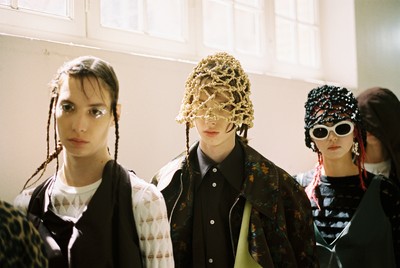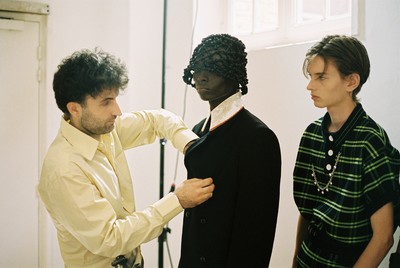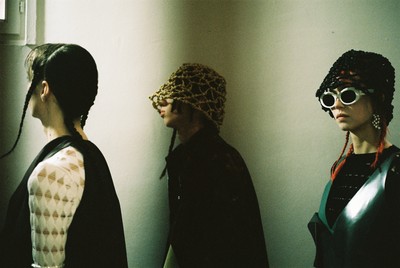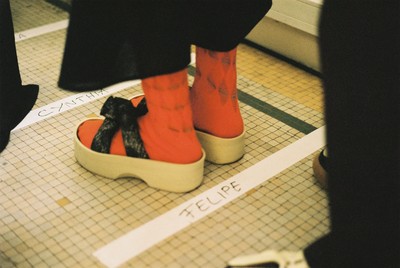In a Namacheko show, founder and aesthete Dilan Lurr creates clothes, not entertainment.
By Rahim Attarzadeh
Photographs by Thomas Neaume
In a Namacheko show, founder and aesthete Dilan Lurr creates clothes, not entertainment.
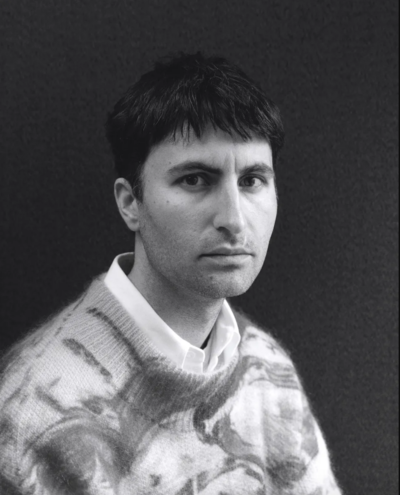
Portrait and imagery taken from Namacheko’s Spring/Summer 2023 show by Thomas Neaume.
The name Namacheko is something the brand’s founder Dilan Lurr came across accidentally in 2017. It just so happens that Namacheko is also the name of a coffee, although now probably better known as Dilan’s fierce adaptation of his Kurdistani roots, Swedish upbringing, and Antwerp base. Having studied art and civil engineering, Lurr has been issuing an under-the-radar challenge to the mens and womenswear status quo. Over recent collections, the designer’s art education background has led to his aestheticised admiration and appreciation of artists such as Barbara Hepworth, Vincent Van Gogh, and Edvard Munch – all intertwined within a Kurdistani framework of desirability and laying the foundations for Namacheko’s burgeoning appeal.
For the brand’s Spring/Summer 2023 offering, the show took place on a Sunday afternoon in the courtyard of École Duperré School of Applied Arts. Located in the Marais district of Paris, it was an appropriate nod to where Lurr’s color-coded and sharply-silhouetted tropes were first stocked around the corner from the neighbourhood’s fabled and famed concept store, The Broken Arm, back in 2017. It became abundantly clear that Lurr is more interested in developing a brand that could be a cultural creative container rather than producing anything ‘trendy,’ or ‘of the moment.’ In devising clothing that not only referenced Georgia-born Armenian poet Sayat-Nova, Turkish (not Japanese) men’s kimonos, and the opulence of the Ottoman Empire’s sartorial robes, Lurr’s hopes for the collection proves that he wants to culture-clash, or rather, culture-combine. ‘There’s so much information out there. We are therefore exposed to everything; all cultures, just like in my youth,’ he tells System.
With the SS23 collection showcasing an amalgam of ‘Cobainesque’ eyewear, deconstructed mesh footwear, and biker-chain adorned trousers, Lurr’s first foray into designing accessories was all forged by his steadfast independent approach. ‘Independence is a very important aspect of Namacheko. I’m not necessarily interested in collaboration unless it benefits the brand in the long-term. I am striving to achieve longevity. I’m not really concerned about lending my name to something ephemeral.’
System caught up with Lurr to discuss his recent show, the power of autonomy and why he doesn’t want his ethnicity to singularly define his creative legacy.
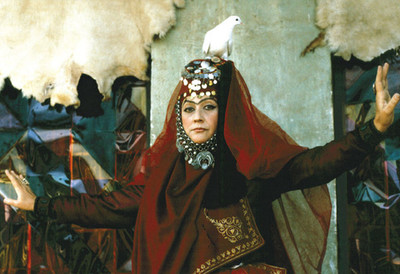
All reference imagery sourced from Namacheko’s archive.

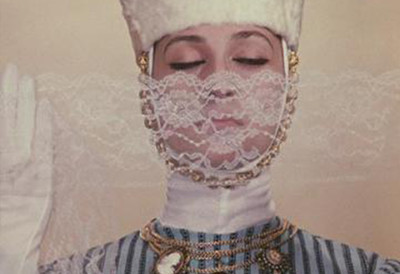
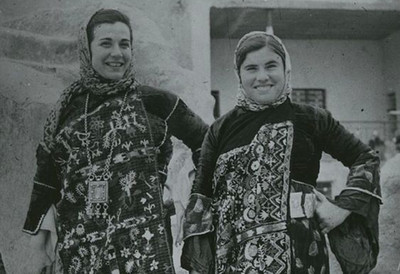
You grew up in Sweden but you’re from Kurdistan. How important has your Middle Eastern heritage been since developing Namacheko in 2017?
Dilan Lurr: First of all, I like that you say Kurdistan. That’s the correct terminology! When I started developing Namacheko, I didn’t necessarily plan on making a fashion brand specifically. It all began with me wanting to document how my cousins dressed. I am very proud of being Kurdish and I wanted to aestheticise that.
I remember reading that your initial designs were based on what your cousins wore to weddings back home?
Dilan Lurr: Very much so. I was interested in dressing men and women because they are so conservative where I’m from. The notion of creating clothing that can be worn by both men and women was always very important to me. Where I’m from, that doesn’t exist.
Were you encouraged to be creative as a child? There is often this stereotype that Middle Eastern creatives, or designers were restricted in their youth, which is not always the case.
Dilan Lurr: I wouldn’t say my parents restricted me in any way. However subjects like art or sports were never considered a priority. It was very much a case of ‘get a good education, get a good degree, get a good job.’ That was most important. My dad is a goldsmith and he is very proud of that. His whole family are goldsmiths. They are very dedicated to their craft. The ideology of heritage and the endurance that comes with it was always instilled in me growing up.
‘First of all, I like that you say Kurdistan. That’s the correct terminology!’
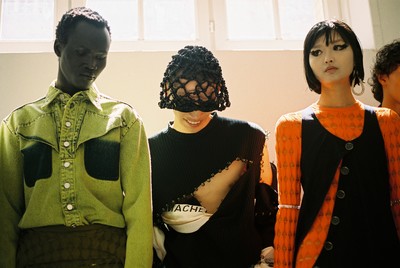
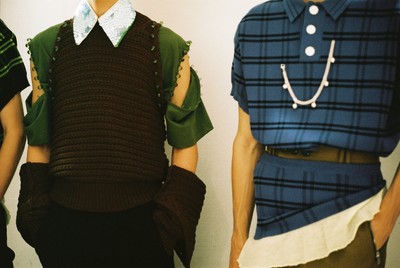
Before we talk about your new collection in more detail, I noticed that you designed jewelry for the first time. What did your father think when he saw the designs?
Dilan Lurr: He liked them! I think he’s proud that I’m designing jewelry as it’s something he feels like he can resonate with in my work. It goes back to what I was saying about heritage – he sees my jewelry designs as me carrying on his family’s legacy.
You and your sister Lezan moved to Sweden from Kurdistan in 1997. You once said that you don’t consider yourself a Swedish designer because you always felt that they were too ‘safe.’ How do you balance an ‘East meets West’ philosophy as Namacheko develops a larger presence in fashion capitals like Paris?
Dilan Lurr: It’s about mastering a balance between the two. It’s not a case of one influence, or region having to overpower the other. Of course, some of my more recent designs have been influenced by Swedish fashion but there’s more of an artistic element attached to them. Bringing in my heritage in an abstract or aesthetic way is very important to me. I don’t want my ethnicity to solely define my designs, or myself as a creative. I design what I feel represents my vision for Namacheko – it’s a combination of the above. Namacheko shouldn’t only be interesting to the industry or the buyer because I’m a designer from Kurdistan. It’s a fashion label and I consider myself a true designer.
You mentioned how your recent designs are more closely connected to Sweden and subsequently Swedish fashion. Is that because of the shapes and silhouettes having minimalist influences? The sharp tailoring as well. Whilst Swedish designers at times reject the use of too many colors and patterns, you embrace them. Namacheko has played host to a series of different color codes and kaleidoscopic swirls. There are still those underlying differences within your work.
Dilan Lurr: That’s very much on point. I didn’t think of that! There is certainly a level of respect for Swedish fashion within my work. At times I have just felt like when I’m in Sweden, I’m in this box. As a creative, I think it’s important not to put yourself in boxes. We live in a modern world. When my sister and I moved to Sweden, my parents couldn’t speak a word of English. So if they could learn a new language then why can I not do the same and therefore forge my own brand? Namacheko is my understanding of a new visual language.
‘Namacheko shouldn’t only be interesting to the industry or the buyer because I’m a designer from Kurdistan. It’s a fashion label and I consider myself a true designer.’
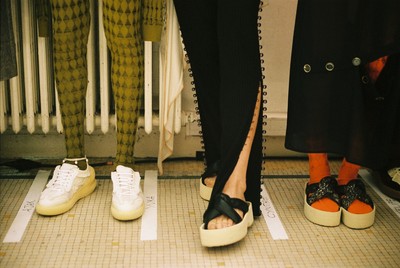
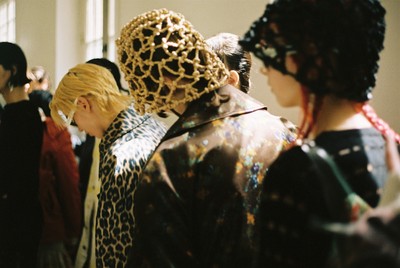
Let’s talk about your Spring/Summer 2023 show. Can you talk me through the collection, the references and the motifs? Your appreciation of history is something you always seem to champion into silhouettes and alluring patterns.
Dilan Lurr: My collection is fundamentally about Kurdish women. The way they dress, the way they carry themselves and how eclectic they are. I’ve been thinking a lot about that area in between Iraq and Iran throughout history and the different tribes and cultures who occupied those lands. There were the Ottomans of course, but also the British and the French. That’s the way we live now. There’s so much information out there. We are therefore exposed to everything; all cultures, just like in my youth.’ I wanted to bring this together in the collection. Even with Asia. We have designed some kimonos. Did you know that Turkish men also wore kimonos? They wore things that at the time could be considered quite feminine silhouettes. Blending tradition with a multiplicity of cultures but appealing to a modern generation, who also appreciate fashion. That’s integral.
I’ve noticed that you’re launching eyewear and footwear for the first time. We obviously discussed your foray into jewelry earlier. Would you say the notion of creating your own shoes and accessories, as opposed to collaborating with another brand is a nod to the independent spirit of Namacheko? You started the brand based on your sense of autonomy and that practice has been emanated through to the footwear designs for instance.
Dilan Lurr: Absolutely. Independence is a very important aspect of Namacheko. I’m not necessarily interested in collaboration unless it benefits the brand in the long-term. I am striving to achieve longevity. I’m not really concerned with lending my name to something ephemeral. We develop everything ourselves, even when we have to source different materials to create the sunglasses from multiple factories.The product will be manufactured where we feel is most authentic to our design DNA. I’ve never had a problem with choice. I just need to know every process that goes into the designing and building of my products. They are an extension of me.
‘I am striving to achieve longevity. I’m not really concerned about lending my name to something ephemeral.’
Just to finish, what are your hopes for the future of Namacheko? Would you like to see it transition further into the mainstream or would you rather avoid the term entirely?
Dilan Lurr: I don’t consider the cult or mainstream. I am just focused on myself and the comfort of doing whatever I want to do. The avoidance of feeling restricted in any sense is still the driving force behind Namacheko. I will forever remain competitive and I am my own harshest critic. I will always feel like I have something to prove but that’s what makes me strive to be better. It’s a part of my culture, coming from Kurdistan.
